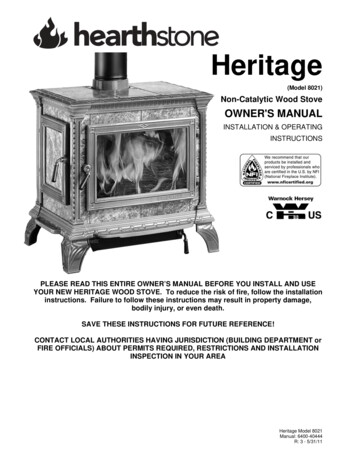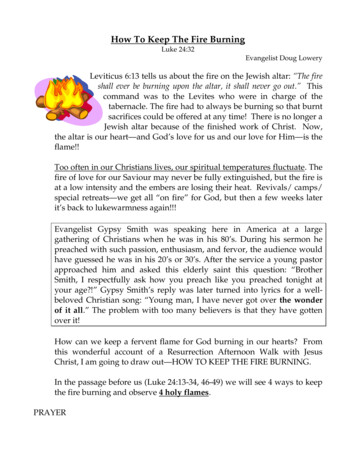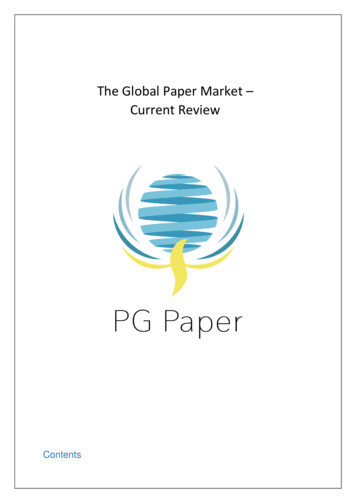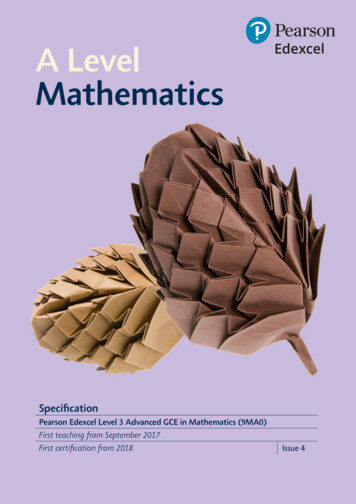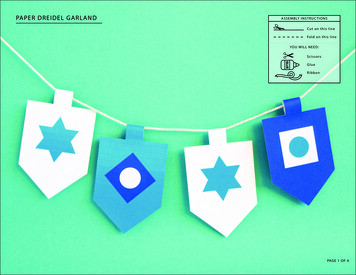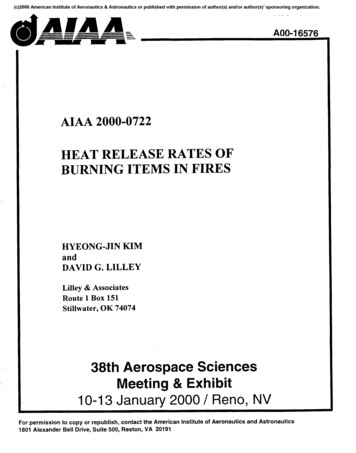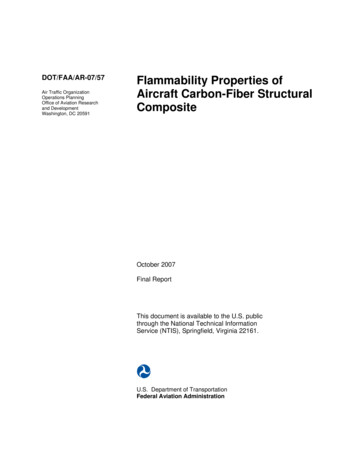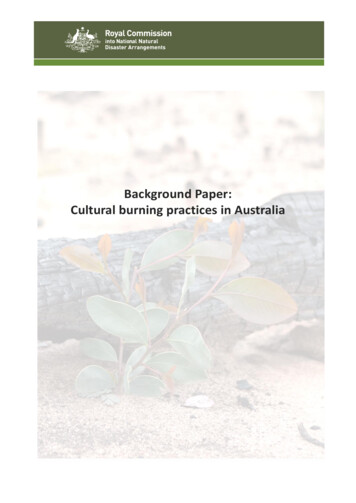
Transcription
Background Paper:Cultural burning practices in Australia
The Royal Commission into National Natural Disaster Arrangements was establishedon 20 February 2020 in response to the extreme bushfire season of 2019-20 whichresulted in devastating loss of life, property and wildlife, and environmentaldestruction across the nation.The Letters Patent for the Royal Commission set out the terms of reference andformally appoint Air Chief Marshal Mark Binskin AC (Retd), the HonourableDr Annabelle Bennett AC SC and Professor Andrew Macintosh asRoyal Commissioners.This paper was published on 15 June 2020. Commonwealth of Australia 2020ISBN: 978-1-921091-17-9 (online)With the exception of the Coat of Arms and where otherwise stated, all materialpresented in this publication is provided under a Creative Commons Attribution 4.0International licence. For the avoidance of doubt, this means this licence only appliesto material as set out in this document.The details of the relevant licence conditions are available on the Creative Commonswebsite as is the full legal code for the CC BY 4.0 licence www.creativecommons.org/licenses The terms under which the Coat of Arms can be used are detailed on theDepartment of the Prime Minister and Cabinet website.Page 2 of 19
ContentsBackground Paper: Cultural burning practices in Australia . 1Introduction . 4Cool and hot fires and the importance of the canopy . 5Cultural burning and prescribed burning . 6Application of Indigenous Fire Management Practices . 6Northern Australia . 6Western Australia . 7Victoria. 9Tasmania. 10New South Wales, South Queensland, South Australia, Australian Capital Territory . 10Carbon farming through fire management . 11Government partnerships . 11Next steps. 12Appendix . 13Indigenous Land and Sea Management Projects . 13Bibliography . 17
Terms of ReferenceWe direct you, for the purposes of your inquiry and recommendations, to have regard to (g) any ways in which the traditional land and fire management practices of Indigenous Australians couldimprove Australia’s resilience to natural disasters.IntroductionIndigenous Australians have used fire to shape and manage the land for over 60,000 years. While thesepractices have been widely disrupted over a number of generations, there is a growing recognition of thevalue of cultural burning, including as a way to mitigate the effects of bushfires. Partnerships with industry,research institutions and governments are reinvigorating the use of cultural burning, and hybrid systems ofland management are being developed.In many parts of Australia, pure cultural burning cannot be undertaken due to the change in climate andthe presence of settlements. Modern cultural fire practices are developed using a blend of customary andwestern techniques to manage land and waters to the benefit of Country and communities across Australia.Many of these practices are relatively consistent in design, such as the use of the mosaic system of burning,however these practices vary in application, due to factors such as the type of vegetation, the presence oldgrowth forests and localised weather effects.This paper provides some background on cultural burning practices in Australia. All views and statementsare drawn from publicly available literature and do not necessarily represent the views of the Commission.FireThere is much evidence of Indigenous use of fire in early-colonial art work, letters and journals. In 1788,Governor Phillip wrote to Viscount Sydney:In all the country thro’ which I have passed I have seldom gone a quarter of a mile without seeing trees whichappear to have been destroyed by fire. We have seen very heavy thunderstorms, and I believe the gum-treestrongly attracts the lightning, but the natives always make their fire, if not before their own huts, at the rootof a gum-tree which burns very freely, and they never put a fire out when they leave the place. 1In 1802, Francois Peron also recorded evidence of Indigenous use of fire:Fire seems to be esteemed as something very superior to all other objects of nature.2The forests in this part of Diemen’s Land are not so thick and large as in the interior of the channel; theyappeared also to have been partly destroyed by fire. 3It was about two o’clock when we arrived off a small bay from hence we beheld a similar spectacle to thatwhich we saw at the time of our entrance in the port N.W. In every direction, black columns of smoke arose;and wherever we turned our eyes, we beheld the forests on fire. 41Noeleen McNamara ‘Australian Aboriginal Land Management: Constraints or Opportunities’ (2017) James Cook University Law Review 26.2Francois Peron, ‘A voyage of discovery to the southern hemisphere, performed by order of the Emperor Napoleon during the years 1801, 1802,1803, and 1804’ (1809) 211.3Ibid 189.4Ibid 191.Page 4 of 19
In the early 1820s, Charles Sturt noted that fire was used to remove underwood in New South Wales:[T]he growth of underwood, so favourable in other countries to the formation of soil, is wholly prevented.There is no part of the world in which fires create such havoc as in New South Wales, and indeed in Australiagenerally. The climate which dries up vegetation induce them to clear the country by conflagration.5In 1836, Charles Darwin visited Sydney and commented on the sparsity of the trees and the prevalence ofgrasslands, much of which is now thick scrub:The extreme uniformity in the character of the Vegetation, is the most remarkable feature in the landscapeof the greater part of New S. Wales. Everywhere we have open woodland, the ground being partially coveredwith a most thin pasture.6Recent scholarship shows that Indigenous Australians have used fire to crack rocks,7 form or temper toolsand weapons,8 develop hunting grounds,9 to keep trade routes and travel corridors open, 10 keep waterways clear,11 or to ensure the germination of seeds.12Burning for land management may be conducted throughout the year, except during summer/the DrySeason, however there are times when cultural burning is more common:RegionNorthern AustraliaNSW/ACTWestern AustraliaSouth AustraliaTasmaniaVictoriaIndicator/SeasonWet to Early Dry SeasonLate Autumn and WinterMid-Late WinterLate AutumnMid-Late AutumnAutumnMonthsJanuary – rdless of the time of year, cultural burns require decisions to be made on the day, taking into accountfactors including the condition of the vegetation and the prevailing weather. For example, the Ngadju ofsouth-west Western Australia note that fires must be lit early in the morning before the sea breezes rise asthe breezes spread fire and allow it to grow out of control.13Cool and hot fires and the importance of the canopyAt the most general level there are two types of fires: hot fire: large, intense and sweeps across the land leaving little behind; cold fire: ‘trickles’ through ground vegetation and burns at a relatively low temperature.14According to the Ngadju if a fire leaves nothing but powdery grey ash behind, the fire was too hot; butwhere the fire leaves lots of charcoal and stick, the fire was the right temperature.15 Cool fires are slow5Charles Sturt, Two expeditions into the interior of southern Australia during 1828, 1829, 1830 and 1831: with observations on the soil, climate andgeneral resources of the colony of New South Wales, Volume 1 (Smith, Elder ad Co. 1834) xxix.6Charles Darwin, The Works of Charles Darwin, Volume 1: Diary of the Voyage of the H.M.S. Beagle (New York University Press, 2010) 343.7Suzanne Prober, Emma Yuen, Mike O’Connor, Lez Schultz, ‘Ngadju Kala: Ngadju fire knowledge and contemporary fire management in the GreatWestern Woodlands’ (2013), 18.8Mbantua, Fire art gallery and cultural museum, Weapons (2020) https://mbantua.com.au/weapons/ .9Multiple, including: al-aboriginal-burning-modern-day-land-management ; -heritage/aboriginal-cultural-burning .10Aboriginal Heritage Tasmania, ‘Aboriginal Cultural Burning’ (13 November 2017) 2 heritage/aboriginal-cultural-burning .11McNamara (n1) 35.12T Vigilante, K Dixon, I Seiler, S Roche, and A Tieu, ‘Smoke Germination of Australian Plants’ (October 1998) Rural Industries Research andDevelopment Corporation publications/98-108.pdf .13Prober, Yuen, O’Connor and Schultz (n7) 19.14University of Melbourne, Is Indigenous burning the key to reducing bushfires in Australia? (31 August 2016) sity/ .15Prober, Yuen, O’Connor and Schultz (n7) 18.Page 5 of 19
moving and do not burn everything, resulting in a mosaic of burnt and unburnt country which removes fuelfor the larger fires late in the dry season.16 These practices do not stop the late season fires, but mayreduce their severity.17A common phrase repeated about cultural burning is ‘the canopy is sacred’, or that ‘you do not burn thecanopy’. The canopy provides shelter and shade, habitat for animals, flowers and the seedbed for the nextseason. A cool fire shouldn’t touch the canopy, a hot fire may destroy it.Cultural burning and prescribed burningCultural burning is the term used to describe burning practices developed by Indigenous Australians toenhance the health of the land and its people. This included burning, or prevention of burning18, ofCountry. Like cultural burning, non-Indigenous “prescribed” or “hazard reduction burning” is the process ofplanning and applying fire to a predetermined area, under specific environmental conditions, to achieve adesired outcome – usually the mitigation of the presence or severity of bushfires. While there arecrossovers between the two practices, Indigenous burning has a cultural outcome, purpose or significance.Application of Indigenous Fire Management PracticesThis section discusses examples of cultural burning in parts of Australia, including examples of its historicaluse in some jurisdictions.Northern AustraliaDespite extensive media coverage of bushfires in the southern parts of Australia, most Australian firesoccur in the northern tropical savanna. The majority of cultural burning also occurs in Northern Australia,with 71% of projects occurring in the Northern Territory, Queensland or Western Australia.19The Australian tropical savanna covers approximately 25% of the Australian mainland and is primarilycomposed of sporadic eucalyptus trees and understorey grass. Rapid growth during the wet season and aprolonged dry season allows fire to quickly spread across the savanna.20Cultural fire practices are important to maintain the biodiversity of the tropical savanna. This involves thelighting of cool fires during the early dry season maintaining and protecting habitat for wildlife whileallowing native seeds that normally bake during a wild fire, to propagate.21In Arnhem Land, fire management has been a part of the culture and landscape for over 50,000 years.22 Inthe late 1990s, traditional owners and scientists discussed the importance of fire in the landscape, leadingto the development of the Western Arnhem Land Fire Abatement project. The project commenced in 2006and is a partnership between the five Aboriginal ranger groups responsible for Western Arnhem Land, theNorthern Territory Government, Northern Land Council, Northern Territory-based scientists andConocoPhillips. The project aims to reinstate Aboriginal-led fire management regimes over the ArnhemPlateau,23 supported by carbon farming incentives.16Kimberly Land Council, Indigenous Fire Management (2020) www.klc.org.au/indigenous-fire-management .17Ibid.18Firesticks, What is cultural burning? ng/ .19Kirsten Maclean, Cathy Robinson and Oliver Costello (eds) ‘A national framework to report on the benefits of Indigenous cultural firemanagement’ (2018), CSIRO 17 https://publications.csiro.au/rpr/download?pid csiro:EP188803&dsid DS1 .20McNamara (n1) 33.21Central Land Council, Indigenous Ecological Knowledge (2020) knowledge .22Jennifer Ansell, Jay Evans, Adjumarllarl Rangers, Arafura Swamp Rangers, Djelk Rangers, Jawoyn Rangers, Mimal Rangers, Numbulwar NumbirindiRangers, Warddekken Rangers, Yirralka Rangers and Yugul Mangi Rangers ‘Contemporary Aboriginal savanna burning projects in Arnhem Land’(2020), 29(1) International Journal of Wildland Fire 1 https://www.publish.csiro.au/WF/pdf/WF18152 .23Ibid 2.Page 6 of 19
Figure 1: Frequency of large fires ( 4km²) from 1997-2005 from NIAA-AVHRR satellite imagery. Line identifies thetropical savanna.24Traditional owners are involved in the delivery of cultural burns in Arnhem Land, both on the ground andvia aerial burning. Aerial burning is the use of an aerial ignition system to burn regions that are difficult toaccess by land-based vehicles or on foot. It reduces fuel loads and establishes a network of strategic firebreaks across the landscape and is commonly complemented by on-ground burning. The two techniquescreate more effective barriers, particularly around sensitive vegetation and cultural sites.25 This approachintegrates customary and western systems in what is often referred to as the ‘two toolbox approach.’26Kakadu National Park has the added complexity of managing wetlands. The spread of grasses limits accessto water and threatens species used for food by traditional owners and birdlife. Traditional owners managethis by burning multiple times over several weeks at the edge of the floodplain, preventing fire fromspreading into the surrounding savanna woodland. In 2014, the CSIRO reported that cultural fire practicesenhances biodiversity and the cultural value of the wetlands for Traditional Owners. For example,researchers found an increased variety of water birds in the wetlands after burning.27Western AustraliaThe land and habitats of Western Australia are vast and varied, and have been cared for by manyIndigenous peoples. The Great Western Woodlands are cared for in part by the Ngajdu Nation and theNgajdu Rangers Group. The Woodlands in the south-west of Western Australia comprises a 16 millionhectare mosaic of temperate woodland, heathland and mallee28 vegetation. It is the largest remainingintact Mediterranean woodland29 in the world and is unique in being able to survive on as little as 250mmannual rainfall.3024Jeremy Russell-Smith and Cameron P. Yates ‘Australian Savanna Fire Regimes: Context, Scales, Patchiness’ (2007) 3(1) Fire Ecology 51.25Ansell, Evans and Ranger Groups (n22) 6.26Rosemary Hill, Petina L Pert, Jocelyn Davies, Catherine J Robinson, Fiona Walsh and Fay Falco-Mammone, ‘Indigenous Land Management inAustralia’ (May 2013) CSIRO 53.27McNamara (n1) 35.28Mallee is the growth habit of certain eucalypt species that grow with multiple stems springing from an underground lignotuber, usually to aheight of no more than 10m.29Mediterranean woodland refers to any biome characterized by dry summers, rainy winters, with broadleaf trees, such as the eucalyptus forestsof southwest Australia.30TERN, Great Western Woodlands Supersite (2020) https://supersites.tern.org.au/supersites/gwwl .Page 7 of 19
Figure 5: Location of the Great Western Woodlands31The Ngadju use many tools, including cultural burning, to manage the Great Western Woodland andprevent uncontrolled fires. These tools include collecting sticks and logs for the campfire and sweeping thelitter with broom bushes. Sweeping is also utilised during the summer when the cockatoos cast downflowers and leaves, and strip off rough bark to stop goannas from climbing to their nests.32While bulldozers can be used to stop fires and create manual fire breaks, they can crack the land (coveredin a layer of algae, lichen and moss)33 creating future issues, including allowing invasive plant species togain footholds in the land through the cracks, removing seeds from the top soil and causing denseregrowth.34 The Ngadju reported that invasive plants tend to burn hotter, which lead to larger and hotterfires reducing the surroundings to ash. Additionally, it is against Ngadju customary law to leave the grounddisturbed. Even cooking pits have to be completely filled in after use.35The Ngadju take advantage of natural fire breaks present in the Woodlands, including vegetation such asthe salt and blue bushes, which are naturally fire resistant, clay pans, soaks, lake systems and rock holesthat are periodically burnt. These natural fire breaks create a mosaic pattern36 in the Woodlands and allowthe Ngadju to plan cultural burns at the right time (identified as when the grass is green, or a few days afterrain, or when rain is coming, and in the warmer seasons, the fire must be started in the morning before thesea breezes rise). Other areas, such as the sandplains burn without human intervention.3731Vivi Lins, Image: Great Western Woodlands location within Australia, (4 May 2016) https://en.wikipedia.org/wiki/Great Western Woodlands#/media/File:Great Western Woodlands location within Australia.jpg .32Prober, Yuen, O’Connor and Schultz (n7) 19.33TERN (n30).34Prober, Yuen, O’Connor and Schultz (n7) 20.35Ibid 20.36Ibid 20-21.37Prober, Yuen, O’Connor and Schultz (n7) 20.Page 8 of 19
The Ngajdu, with the CSIRO, have developed the following summary of fire regimes in the differentelements of the Great Western Woodlands:Figure 6: Summary of the fire regimes38VictoriaTraditional Owners are working to re-introduce cultural burning in Victoria, and are increasingly beingrecognised by the Victorian government as partners in land and water management. With this shift, manyparties support public land managers involving Traditional Owners in land management activities.39For example, the Gunditjmara people work with the Forest Fire Management Section of the Department ofEnvironment, Land, Water and Planning, and the Victorian Country Fire Authority, to undertake cultural firemanagement as part of an overall fire management plan for the Budj Bim National Park.40Traditional Owners across Victoria are keen to work with government and the CFA to reintroduce culturalfire practices, such as vegetation removal and cool burning, around aboriginal art sites. Hot fires candamage culturally significant sites, including by cracking or destroying granite rock faces and destroying artand artefacts.41While traditional owners are keen to reintroduce cultural burning, they note that much of the land may notready for it and that roughly three years of fuel reduction burning must happen before cultural burning can38Prober, Yuen, O’Connor and Schultz (n7) 26.39Victorian Traditional Owner Cultural Fire Knowledge Group, ‘The Victorian Traditional Owner cultural Fire Strategy’ (2019) 4. trategyplusfinal.pdf .40Uncle Denis Rose, Testimony provided for the Royal Commission into National Natural Disaster Arrangements (2020) 116-127 -%20Final.pdf .41Victorian Traditional Owner Cultural Fire Knowledge Group (n39) 20.Page 9 of 19
begin.42 They also note that cultural fire management can only happen in cooperation with the CFA and thefire brigades, using more common fuel reduction burning techniques, and that it is going to take time torelearn cultural fire management and adapt it to the current environment.43Figure 7: Transitioning to cultural fire management in Victoria44TasmaniaTraditional Owners, through the Tasmanian Aboriginal Centre, have partnered with the Firesticks AllianceAboriginal Corporation to undertake training to develop knowledge and skills of cultural burning.45 Culturalburning is undertaken on Aboriginal managed land to assist with fuel reduction, to discourage weeds, andencourage seeds to sprout, bringing back native fauna to areas which have been recently burned.46New South Wales, South Queensland, South Australia, Australian Capital TerritoryThe New South Wales, Parks and Wildlife Services Cultural Fire Management Policy47 sets out the ways inwhich Parks and Wildlife Services staff should work with Traditional Owners to engage in cultural firemanagement.The Murri Rangers in South East Queensland combine ancient fire techniques and modern dronesurveillance48 allowing them to monitor sites and the effect burning is having on the Bunya Mountains,especially the endangered grassy balds.49In South Australia the City of Adelaide is working with local Traditional Owners to re-introduce traditionalfire management to the Adelaide Park Lands,50 while the Murrumbung Rangers have worked with42Ibid 16.43Ibid 16.44Ibid 17.45Tasmanian Aboriginal Centre, ‘Land Management Update, March 2020’ (March 2020) ndManagement-Update-March-2020.pdf .46Aboriginal Heritage Tasmania (n10) 2.47Office of Environment & Heritage, ‘NPWS Cultural Fire Management Policy’ (2016) pdf .48National Indigenous Australians Agency, ‘Cool burning and high flying at Bunya Mountain Murri Rangers’ (21 April 2020) ri-rangers .49Silvie Moravek, Jon Luly, John Grindrod and Russell Fairfax, ‘The origin of grassy balds in the Bunya Mountains, southeastern Queensland,Australia’ (2013) 23(2) The Holocene 2460792 . Grassy balds are patches of grasslands inforested landscapes. In the Bunya Mountains, these balds are embedded in a rainforest, vine thicket and eucalypt woodland matrix.50City of Adelaide, ‘Park Lands Cultural Burn’ (6 March 2020) -park-lands/ Page 10 of 19
ACT Parks and Conservation since 2016 to reintroduce cultural fire management to the national parksaround the ACT.51Carbon farming through fire managementCool burns set in the early dry season emit approximately half the amount of greenhouse gasses producedby the hotter, later, fires and burn less organic matter. For this reason, cool burns can be a source of carboncredits.52 In 2019, savanna fire management projects accounted for 10% of Australian carbon credits issued,providing economic, social, cultural and environmental benefits to participants.53 It is estimated savannafire management carbon farming is providing around 15 million income each year for Indigenous landmanagers across the north by generating and selling carbon credits.54 Researchers have found that culturalfire practices reduce greenhouse gas emissions, and the reductions can be used to offset greenhouse gasemissions by other sectors.Carbon farming remains a popular and viable option for reintroducing cultural burning to many areas ofAustralia, with organisations and foundations providing training and support to traditional owners andlandholders to develop community-based solutions under the Emissions Reduction Fund.55Government partnershipsWhile the Australian Government is the largest investor in Indigenous land management,56 Schultz andothers have noted that Indigenous perspectives may have been historically under-represented in policydevelopment.57 Governments have incorporated Indigenous perspectives into some policy and programs.For example the Caring for our Country Program established in 2008 to develop national priorities to focusmulti-year investment on the protection of the environment and sustainable management of our naturalresources.58 While not indigenous specific, one of the national priorities was Indigenous land managementand Working on Country (Indigenous Land and Sea Ranger Programs).Indigenous Australians have reportedly struggled to obtain equitable or timely access to governmentresources and consideration59 and report that they are asked to co-implement, rather than co-design,programs.60The Victorian Traditional Owners cultural fire knowledge group acknowledges that cultural burningpractices could be taught to non-indigenous people. While they are concerned that the same level of carein land management may not be exercised by those without the cultural connection to country, they arekeen for these practices to become more mainstream.6151Tom Lowrey, ABC News, ‘Indigenous fire practices used in hazard-reduction burns at significant ACT cultural sites’ (1 April 2016) ct/7293212 .52McNamara (n1) 33; Clean Energy Regulator, ‘Fighting fire with fire in Fish River’ (2016) ire-with-fire-in-fish-river .53Ansell, Evans and Ranger Groups (n22) 2.54The Nature Conservancy, ‘Indigenous fire revolution’ (20 February 2020) nous-firerevolution/ .55Aboriginal Carbon Foundation https://www.abcfoundation.org.au/ .56Ansell, Evans and Ranger Groups (n22) 2. A list of federally funded projects is set out in the Appendix.57Schultz, Rosalie, Tammy Abbott, Jessica Yamaguchi and Sheree Cairney, ‘Indigenous land management as primary health care: qualitative analysisfrom the Interplay research project in remote Australia’ (2018) 18(960) BMC Health Services 7.58Department of Agriculture, Water and Environment, ‘Previous programmes’ /previousprogrammes .59Hill, Pert, Davies, Robinson, Walsh and Falco-Mammone (n26) 53.60National Indigenous Australians Agency, ‘NDIS East Arnhem Land Co-Design Project Evaluation - Final Report’ (2018) 24 n 1.pdf .61Victorian Traditional Owner Cultural Fire Knowledge Group (n39) 19.Page 11 of 19
Next stepsThe Royal Commission will hear from Indigenous cultural burning practitioners, researchers andorganisations during the course of its inquiry, and will not make findings or draw conclusions on how suchpractices may improve Australia’s resilience to natural disasters, until it has completed this process.Page 12 of 19
AppendixIndigenous Land and Sea Management Projects62* public sources do not indicate fire management is undertaken.No001Region ProjectNSWBarkindji Maraura Rangers002NSWBoorabee and The Willows IPA003004005006007NSWNSWNSWNSWNSWBrewarrina Ngemba Billabong IPADorodong IPAGamay Botany Bay RangersGithabul RangersGumma IPA*008NSWMid North Coast Aboriginal umai IPA and Jahnala Yenbalehla RangersNgulingah Nimbin Rock RangersNgunya Jargoon IPATarriwa Kurrukun IPA and RangersToogimbie IPAWattleridge IPA and RangersWeilmoringle IPAWillandra Lakes World Heritage Area RangersWorimi Green TeamAnangu Luritjiku RangersAngas Downs IPA and RangersAnindilyakwa IPA and RangersAnmatyerr RangersAsyrikarrak Kirim RangersBulgul Land and Sea RangersCrocodile Islands Rangers025026027NTNTNT028029NTNTDhimurru IPA and RangersDjelk IPA and RangersGanalanga-Mindibirrina IPA and the Garawaand Waanyi/Garawa RangersGarngi RangersJawoyn Rangers030NT031NTKatiti-Petermann IPA, Kaltukatjara Rangers andMutujulu Tjakura RangersLaynhapuy IPA and Yirralka Rangers032033NTNTMalak Malak Land Management RangersMangarrayi Rangers034NTMardbalk Marine RangersAdministrative OrganisationBarkindji Maraura Elders EnvironmentTeam LtdGlenn Innes Local Aboriginal LandsCouncilBrewarrina Local Aboriginal Land CouncilDorodong Association IncLa Perouse Local Aboriginal Land CouncilBorder Rangers Contractors Pty LtdNambucca Heads Local Aboriginal LandCouncilTaree Indigenous Development andEmploymentMinyumi Land Holding Aboriginal CouncilNgulingah Local Aboriginal Land CouncilJali Local Aboriginal Land CouncilBanbai Business
the breezes spread fire and allow it to grow out of control.13 Cool and hot fires and the importance of the canopy At the most general level there are two types of fires: hot fire: large, intense and sweeps across the land leaving little behind; cold fire: Ztrickles through groun
